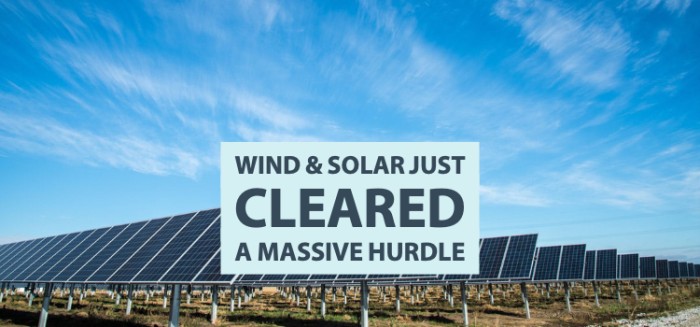Wind and Solar Just Cleared a Massive Hurdle
 | Isak Kvam, Communications / Policy Associate |

 | Isak Kvam, Communications / Policy Associate |
Every November, energy wonks gather around their computers, eagerly awaiting the release of Lazard’s annual Levelized Cost of Energy (LCOE) report. This report is a deep dive into the unsubsidized costs of different electricity sources in the U.S. - coal, natural gas, wind, solar, etc. - and gives us an apples-to-apples comparison. This is important because when it comes to choosing how we generate our electricity, cost is by far the most important factor. This year’s big finding: the cost of wind and solar continue to drop and have become even cheaper than operating existing coal plants in many areas of the U.S.
First, let’s talk prices. Wind energy is currently the cheapest way to make electricity in the U.S., with an average price of $26-56/Megawatt-hour (MWh). Solar energy is close behind at $36-44/MWh. Operating existing coal plants averages $27-45/MWh, and building new plants costs $60-143/MWh. Building a new natural gas combined cycle plant costs $41-74/MWh. That means that even without subsidies, renewables are beating fossil fuels on price alone.
The utility wind boom
The trend of new renewables becoming cheaper than running existing coal plants has begun to spread throughout the U.S. It began in the upper Midwest when Xcel Energy announced it was replacing half of its coal-fired capacity with cheap wind power in 2016. In fact, CEO Ben Fowke stated they were finding wind projects offering prices as low as the low teens [in $/MWh]. Plus, since wind has no fuel cost, that low price is locked-in for the full 25-year life of the project. This is dramatically different than natural gas and coal, whose prices fluctuate and are thus inherently more risky. Today, Xcel Energy has the second-most installed wind capacity of the nation’s electric utilities, after Berkshire Hathaway Energy.
Xcel Energy also made waves in Colorado earlier this year when renewable energy developers offered electricity at the lowest prices quoted in the nation with wind, solar, and energy storage. Xcel Energy’s Clean Energy Plan would shutter two older coal plants totaling 660 MW if a lower-cost alternative could be found - including the cost of closing the plants 10 years early. Xcel Energy didn’t have to look far. They plan to add 1,100 MW of wind power, 700 MW of solar, and 225 MW of energy storage (tied to solar projects) to power 55 percent of their electricity generation with renewables by 2026. The best part: it’ll create a savings of $213 million for their customers.
The story of cheap renewables doesn’t stop there. Utilities across the nation are beginning to replace their coal generation with cheaper renewables.
Another utility recently announced it was going all-in on renewables, and it comes from one of the unlikeliest regions. Indiana is currently #7 in coal production and #3 in coal consumption across the U.S., but that may not be true for very long. Northern Indiana Public Service Company (NIPSCO) in Indiana recently announced it will replace all five of its coal-fired units earlier than planned. Their reasoning: adding renewables - solar, wind, energy storage, and demand response - is cheaper for its ratepayers- to the tune of $4 billion over the next few decades.
NIPSCO’s coal use will decrease from 65 percent today to 15 percent in 2023 down to zero in 2028. The electric utility will have to make upgrades to its system for the switch, however replacing its 1,800 MW of coal will curb their carbon emissions by over 90 percent and will be the cheapest way to keep the lights on. The only news that’s perhaps even bigger than this recent announcement is the fact that this switch isn’t a political battle; market prices are driving the transition to renewables.
It’s no surprise that low-cost renewables are bringing huge savings to the utilities that invest in them. They say everything is bigger in Texas - and that holds true for its amount of wind power. The state has the most installed wind capacity in the nation with nearly 23.5 GW. And all that wind power is bringing a slew of benefits for the Lone Star State. A new report from TXP and IdeasSmiths recently found that renewables - largely wind power - has saved Texans $5.7 billion between 2010 and 2017. Last year alone, wind power brought $210 million in tax revenue to local governments, $90 million for farmers and ranchers that lease their land for turbines, and over $855 million in customer savings for ratepayers. We know that wind power brings more benefits than just cheaper energy - but that’s a sizable chunk of change for one year of wind power!
Energy storage enters the mix
Subscribe to our newsletter for the latest on energy & our work
Utilities originally though that natural gas would be needed as a bridge between our coal-dependent past and a high-renewable future. Because wind and solar aren’t always generating power, natural gas filled in as the go-to resource to ramp up or ramp down quickly to make power when we need it. But in many areas, utilities are already looking at energy storage to fill that role instead. Look no further than California, where regulators just approved PG&E’s plan to replace three natural gas plants with energy storage instead thanks to low battery prices.
Lazard found that lithium-ion batteries showed a significant cost decline in 2018, but that may face growing pains in the coming years as more batteries are built. This is due to rising cost pressures from higher prices for metal commodities (like cobalt and lithium carbonate), as well as a tightening supply. The energy storage industry is relatively new and will have to scale-up quickly - but if it follows the lead of wind and solar power, its future is bright.
This blog post originally appeared in Morning Consult.